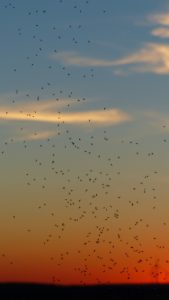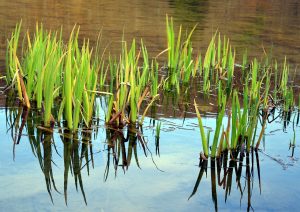The Maddening Mosquito: Pesky and Pervasive
This post was written by guest blogger Rebecca Kennedy.
Sunday, August 20 is World Mosquito Day! This annual day commemorates a major development in public health—the landmark 1897 discovery of the female Anopheles mosquito as the transmitter of malaria. The person behind this breakthrough was British physician Sir Ronald Ross, who went on to receive the 1902 Nobel Prize for Medicine for his pioneering work on the devastating disease. Thankfully, malaria is no longer found in Canada; however, the disease continues to persist elsewhere—worldwide in 2015, there were 212 million cases and over 400,000 deaths from the disease, disproportionately occurring in sub-Saharan Africa.
There are around 3,000–3,500 species of mosquito depending on whom you ask. They belong to the family Culicidae and the genera Anopheles, Culex, and Aedes. Over 80 species are found in Canada. The lifespan of a mosquito is mercifully short—ranging from a scant two weeks to six months.
 Only the Anopheles mosquito transmits malaria; however, different species are vectors for other grave infectious illnesses. For instance, the Culex variety spreads encephalitis and West Nile virus, while Aedes varieties such as the Aedes aegypti transmit dengue, yellow fever, and both West Nile and Zika viruses. While found mainly in tropical regions, such as sub-Saharan Africa and South Asia, these diseases could be transmitted by mosquitoes in Canada should a local mosquito become infected. For example, the first human case of West Nile virus infection occurred in Ontario in 2002. Although Canada has relatively very few cases of West Nile virus transmission to humans (just 80 in 2015), it is still advisable to take precautions. Regarding Zika virus, the main transmitting species of mosquito, Aedes aegypti, doesn’t live in Canada, as our climate is too cold for them. That said, it is still unknown whether the mosquito species that do reside here could become Zika carriers.
Only the Anopheles mosquito transmits malaria; however, different species are vectors for other grave infectious illnesses. For instance, the Culex variety spreads encephalitis and West Nile virus, while Aedes varieties such as the Aedes aegypti transmit dengue, yellow fever, and both West Nile and Zika viruses. While found mainly in tropical regions, such as sub-Saharan Africa and South Asia, these diseases could be transmitted by mosquitoes in Canada should a local mosquito become infected. For example, the first human case of West Nile virus infection occurred in Ontario in 2002. Although Canada has relatively very few cases of West Nile virus transmission to humans (just 80 in 2015), it is still advisable to take precautions. Regarding Zika virus, the main transmitting species of mosquito, Aedes aegypti, doesn’t live in Canada, as our climate is too cold for them. That said, it is still unknown whether the mosquito species that do reside here could become Zika carriers.
Not all species bite. Of those that do, only adult females draw blood, which they use as a protein source for their eggs. (And technically speaking, a mosquito doesn’t bite—more accurately, it cuts and drills into your skin.) Only females have the complex mouthparts used to pierce and pump blood—a long, thin, tube-like structure called a proboscis that contains six needle-like parts that collectively work to locate blood vessels and suck blood. The itchiness and irritation at the site of a bite is caused by an anticoagulant enzyme in the mosquito’s saliva which produces an allergic reaction on the victim’s skin.
Mosquitoes are cold-blooded, meaning they like warmer weather. In Canada, they are most abundant from May into July, but can endure throughout the entire summer and then become dormant during chillier times. Some species can be extinguished by below-freezing temperatures. Weather and topographic conditions, including the amount of rainfall and whether that precipitation drains or pools, play a key role in determining their presence and prevalence.
With this knowledge in mind, here are three recommendations to help you plan a hike and keep mosquitoes at bay:
 Hike when and where mosquitoes are least active. Mosquitoes can bite at any time of day, but generally in Canada they are most active around dusk and dawn, as well as evening hours after dark, so schedule your hike accordingly. When choosing a place to hike, factor in the area’s general geography and environmental conditions. Mosquitoes are largely found in and around still, stagnant water—ponds, swamps, marshes, lake edges, and moist soil—as that’s where breeding occurs. Windy areas are not ideal to mosquitoes because even the slightest breeze will hinder their flying. During daylight, if temperatures are hot, they will congregate in shady areas.
Hike when and where mosquitoes are least active. Mosquitoes can bite at any time of day, but generally in Canada they are most active around dusk and dawn, as well as evening hours after dark, so schedule your hike accordingly. When choosing a place to hike, factor in the area’s general geography and environmental conditions. Mosquitoes are largely found in and around still, stagnant water—ponds, swamps, marshes, lake edges, and moist soil—as that’s where breeding occurs. Windy areas are not ideal to mosquitoes because even the slightest breeze will hinder their flying. During daylight, if temperatures are hot, they will congregate in shady areas.
Wear protective clothing and minimize your scent. Cover yourself and your kids. Think light colors, loose clothing, and long sleeves. Avoid cotton and linen and choose clothing made from tightly woven fabrics, such as nylon or polyester, which make it harder for the bugs to reach your skin. If possible, tuck your pants into your socks. Keep in mind that mosquitoes fly very close to the ground, so take extra care to protect the lower half of your body. If you are doing more than a casual hike, consider using a netted hat and purchasing permethrin-treated clothing, which although not available to civilians in Canada, is not banned and can be purchased online from U.S. vendors. Reduce or avoid the use of scented hygiene products—shampoo, deodorant, or body wash—before your hike, and do not wear cologne or perfume.
Use proven mosquito repellents on both your clothes and your skin. In Canada, only repellents that have been approved by the government for their safety and effectiveness are sold. Visit Health Canada’s Insect Repellents web page for a list of approved insect repellents and recommended concentrations for adults, children, and infants. Repellents are available in several forms, such as sprays, lotions, and moistened wipes. Their active ingredients are DEET, icaridin (known as picaridin in the United States), soybean oil, citronella oil, P-Menthane-3,8-diol, or a mixture of essential oils derived from lemon, eucalyptus, pine needle, geranium, and camphor. Whatever you use, follow the manufacturer’s directions carefully and be mindful of age restrictions and potential allergic reactions to ingredients.
Acknowledgements: The Canadian Encyclopedia, Canadian Paediatric Society, Florida Medical Entomology Laboratory, Health Canada, MacLean’s, Malaria Journal, National Geographic, Prevention Magazine, U.S. Centers for Disease Control and Prevention, U.S. Environmental Protection Agency, World Health Organization




